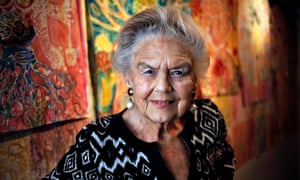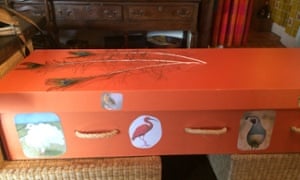Sheila Kitzinger, the natural childbirth activist who died in April, pioneered the idea of birth plans. Her daughters, Celia and Jenny, describe how their mother made a death plan – so she could die at home according to her own wishes
By Celia and Jenny Kitzinger

Our mother, Sheila Kitzinger, champion of women’s rights in childbirth, died in April. In writing her own fantasy obituary for a newspaper many years earlier, she imagined dying at the height of her powers: “She died as she would have wished, flat on her back on a table with her legs in the air, in front of a large audience, demonstrating with vigour the dangers of making women lie down, hold their breath till their eyes bulge and strain as if forcing through a coconut to push a baby out. She claimed that treating the second stage of labour as a race to the finishing post … could result in cardiac arrhythmia and even a stroke. She made her point.”
Rather than the melodramatic early death she conjured up here, Sheila died quietly at home surrounded by her family, at the age of 86.
Sheila spent her life campaigning for autonomy and choice in childbirth and challenging the medicalisation of birth. She pioneered birth plans to support women in making their own decisions. When it came to dying, she expressed the same values of choice and control, and she planned ahead. She appointed one of our sisters, Tess, with lasting power of attorney for health and welfare and also wrote an advance decision. This preparation was invaluable in ensuring that her choices were respected and in allowing her to die at home as she wanted.
Being at home was essential to her idea of a “good death”. She wanted to be in familiar surroundings, on her own territory, with the support of those who knew her. She particularly did not want to go into hospital, aware as she was of the cascade of interventions that can befall people at the end of life, just as they can women in childbirth.
In her autobiography, she records that Cicely Saunders, founder of the modern hospice movement, once said to her backstage at a conference where they were both speaking, “You and I are doing the same work.”
Her concerns about hospital treatment had also been cruelly refined and reinforced by our family experience of the treatment of our sister, Polly, who was severely brain injured in a car crash six years ago. We were all very aware of how institutions have their own systems, policies and agendas that can strip control from the individual.
Sheila wrote about her own mother’s death decades earlier. Following a brain haemorrhage, her mother could no longer swallow, and Sheila resisted a feeding tube. “I consulted Father and we both agreed, ‘No. She would want to be at home. She wouldn’t want invasive procedures.’ Later he told me that he wished he had the courage to care for his father that way when he was dying. Instead, he had him admitted to hospital and everything was done to prolong his life by every means possible. Looking back on it, he thought it was wrong, and now he felt guilty.”
At 86, Sheila had cancer and many other diseases of old age. After the first bout of cancer a year earlier, she had accepted treatment. When the illness returned she declined further investigation or intervention.
As her health declined she lost interest in eating or drinking – it was painful to watch her become progressively thinner and more frail. At times she was able to enjoy someone reading to her, she would gamely invite the family join her to sip a little sparkling wine or eat a chocolate, and the ritual of tea at 5pm still seemed to give her pleasure. But it was deeply distressing to witness how vulnerable she became.
In the last few months of her life, Sheila stopped talking about planning her next book and talked with us about her wishes for her death. She also revisited and confirmed the short advance decision (AD) she had written some years earlier. This was a single paragraph (signed and witnessed, and legally binding on her carers and medical professionals) which declared: “If the time comes when I can no longer take part in decisions for my own future, I want to receive whatever quantity of drugs can keep me free from pain or distress, even if death is hastened. If there is no reasonable prospect of recovery I do not consent to be kept alive by artificial means. I do not wish to be transferred to hospital and should like to die in my own bed.”
Except for the last few days, when she was unconscious, Sheila was able to communicate her wishes herself. But her AD was immensely valuable in supporting her choices. Her GP surgery tried to insist, a few weeks before she died, that Sheila should be transferred to hospital after a “mini-stroke”. She said no. The GP questioned her mental capacity to refuse hospitalisation. We read out her AD and she stayed home.
Later her AD was useful when another doctor was considering transferring Sheila to hospital to clarify her diagnosis and it helped her to avoid various interventions. One of the last whole sentences Sheila said was, “I decline antibiotics if I get pneumonia” and, later, she nodded when offered morphine. Anyone in doubt about her capacity to make her own choices, or concerned to ensure they had done everything possible as a healthcare professional, could read her AD or talk with her LPA for health and welfare – and be empowered to provide “person-centred care” with confidence that they knew what her wishes were.

A home death is not right for everyone. We were lucky that Sheila’s symptoms were well controlled, and that’s not always possible at home. The whole situation placed many demands and stresses on the whole family. However, once it was (belatedly) agreed that she was at the “end of life” we were provided with well-coordinated NHS support. It also helped that we are a large family so when one of us was at the end of her tether, another could step in.
This support structure allowed Sheila to die, as she had lived, on her own terms. It also allowed us to have positive memories of the last weeks of her life – and that now helps us with our grief.
Sheila’s burial reflected the values she had lived by – and was shaped by her own distinct choices. She was critical of the “business” of funerals and preferred not to have her body handed over to the professionals. Instead, the day after she died, we – her daughters – washed and dressed her body one last time and carried her downstairs to place her in a bright orange cardboard coffin, decorated with peacock feathers.
Sheila opted for a simple, private burial – much to the surprise of some friends and colleagues who had expected an opulent public funeral extravaganza. Sheila wanted her body buried “without fuss”. So we carried her coffin from the house, to a tune from our time in Jamaica in the 1960s, placed it in the back of a car, and drove to a woodland burial ground. We lowered the coffin into the ground, scattered it with sprigs of rosemary and camellia blossom from our lovely garden and read some of Sheila’s own poetry:
“After the soaring, a peace
like swans settling on the lake
After the tumult and the roaring winds,
Silence.”
